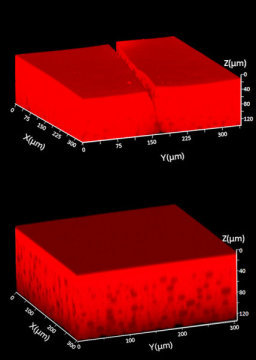Damaged material, heal thyselfInspired by healing wounds in skin, a new approach protects and heals
Damaged material, heal thyselfInspired by healing wounds in skin, a new approach protects and heals surfaces using a fluid secretion process. In response to damage, dispersed liquid-storage droplets are controllably secreted. The stored liquid replenishes the surface and completes the repair of the polymer in seconds to hours.The fluid secretion approach to repair the material has also been demonstrated in fibers and microbeads. This bioinspired approach could be extended to create highly desired adaptive, resilient materials with possible uses in heat transfer, humidity control, slippery surfaces, and fluid delivery.A polymer that secretes stored liquid in response to damage has been designed and created to function as a self-healing material. While human-made material systems can trigger the release of stored contents, the ability to continuously self-adjust and monitor liquid supply in these compartments is a challenge. In contrast, biological systems manage complex protection and healing functions by having individual components work in concert to initiate and self-regulate a coordinated response. Inspired by biological wound-healing, this new process, developed by researchers at Harvard University, involves trapping and dispersing liquid-storage droplets within a reversibly crosslinked polymer gel network topped with a thin liquid overlayer. This novel approach allows storage of the liquid, yet is reconfigurable to induce finely controlled secretion in response to polymer damage.Read more. -- source link
Tumblr Blog : materialsscienceandengineering.tumblr.com
#materials science#science#liquids#polymers
